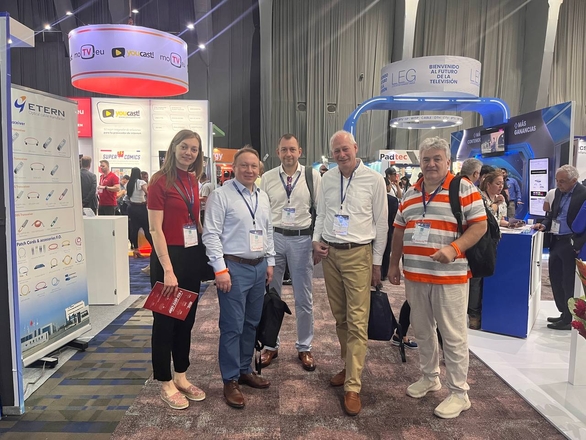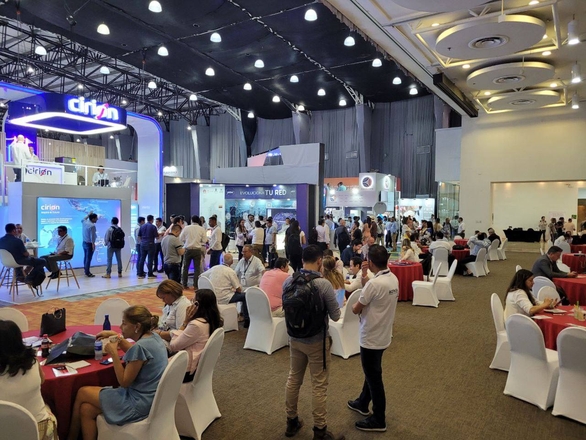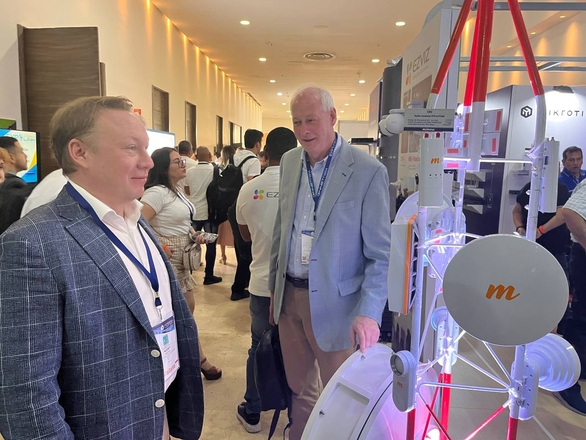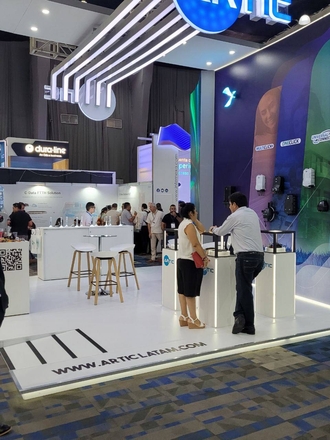Andes Express: RSCC at Andina Link 2023 Exhibition
“Andina Link 2023, one of the largest commercial exhibitions in Latin America, takes place from March 6 to 9 in Cartagena (Colombia); this year it unites more than 140 exhibitors and four thousand attendees from 34 countries”, Luz Marina Arango, Andina president, said at the opening.
The companies making the communications value chain in Latin America: pay-TV operators, Internet service providers, cable broadcasters, audiovisual companies, content producers, OTT video platforms and satellite operators were represented at Andina Link 2023. RSCC was represented at the exhibition by Alexey Volin, Director General, Kirill Filippov, Adviser to Director General, Alexey Vdovin, Head of Business Development Service, and other employees of the Service.
FICA Forum (Ibero-American Convergence and Audiovisual Forum) was one of the central events at Andina Link 2023. It is the main platform for discussing new trends and recent tech achievements in the telecommunications industry, including the Internet of Things, media-content delivery, as well as industry regulatory issues. Sandra Urrutia Perez, Minister of Information and Communication Technologies of Colombia, opened the exhibition and conference. She presented the Ministry's Connect ICT Vision 360 Plan, which primarily aims at significantly improving the country's connectivity from the current 60.5% to 85% of residents. Sandra Urrutia Perez also outlined the strategic priorities of Colombia telecommunications infrastructure development in 2023, including construction of communications trunking, neutral platforms, connection of social facilities and communications in remote regions.
Experts discussed at the forum and exhibition whether platforms would displace pay TV, a satellite would give way to optic fibre, and how to arrange smart cities in Latin America. Most participants in the event made a conclusion that in competition between platforms and television, the positions of the latter remained extremely strong. In Colombia, for example, 90 per cent of the population watches television, and only 60 per cent uses the Internet. Television channels, including pay ones, gather a much larger audience than the Internet platforms. At that, they also hold a much stronger economic position. Pablo Mancusopri, President of Accion Group noted: “Although the telecommunications market grows today mainly due to video content, streaming platforms, unlike TV channels, still lose profits from the current business. This also includes such giants as Disney, Warner Bros., Discovery and НВО”. Currently, there are 6 million pay-TV subscribers in Colombia. Almost half of them is accounted for America Movil headquartered in Mexico. And about 24% of subscribers use the services of Colombian Tigo from the city of Medellin.
The priority of television preserves the demand for satellite capacities in the region. Intelsat Company keeps the leading positions here, but other major foreign operators are present in the market as well.
“The demands for satellite bandwidth in the Latin American region are extremely high, and RSCC has everything needed to occupy its fair niche here. Our services may be required for connecting remote rural areas to the Internet, for ships and aircraft, as well as for transmitting television and audiovisual content that constantly grows in volume here”, Alexey Volin, Director General of RSCC, said.
RSCC, as a global operator, carrying on business in 58 countries, has recently been licensed to operate in the region: last year the Andean Community included Express-AM8 in the register of satellites available for the official provision of communications and broadcasting services in Colombia, Peru, Bolivia and Ecuador. Moreover, the RSCC, together with its partners from Brazil, constructed a monitoring station in the city of Uberlandia: now it covers the entire Latin American region.
Thus, the whole range of services based on the Express-AM8 satellite is available to the customers in this region.
According to the study of the use of information and communication technologies in households (ENTIC Hogares), there is a great difference between households in large cities, where 66.6% have access to the Internet, and households in rural and remote areas, where only 23.9% are connected. It is possible to cover these areas only using satellites.
In Colombia, for example, 500-700 thousand new citizens join the network every year. Jairo Gomez Gaon, a representative of Mas TV in Colombia and other Latin American countries, noted that the Internet actively penetrates into rural areas. Saying that, small provincial settlements are of no interest to the big players at the moment, smaller operators enter this niche. But they cannot afford laying optic fibre by themselves, and therefore look for an inexpensive satellite bandwidth.
For his part, Leonardo Antonio Rodriguez, CEO of the Latinoamericana TCA Group, said that providers have to constantly enhance the bandwidth, stability and quality of their connections, because consumption of the content by the audience grows rapidly. Optic fibre provides higher speed, but it is not suitable everywhere. And this keeps the demand for satellite communications services high enough. Colombia alone has 11 local satellite ground stations operating. And this is despite 8 international underwater fibre optic communications links available to the country.




